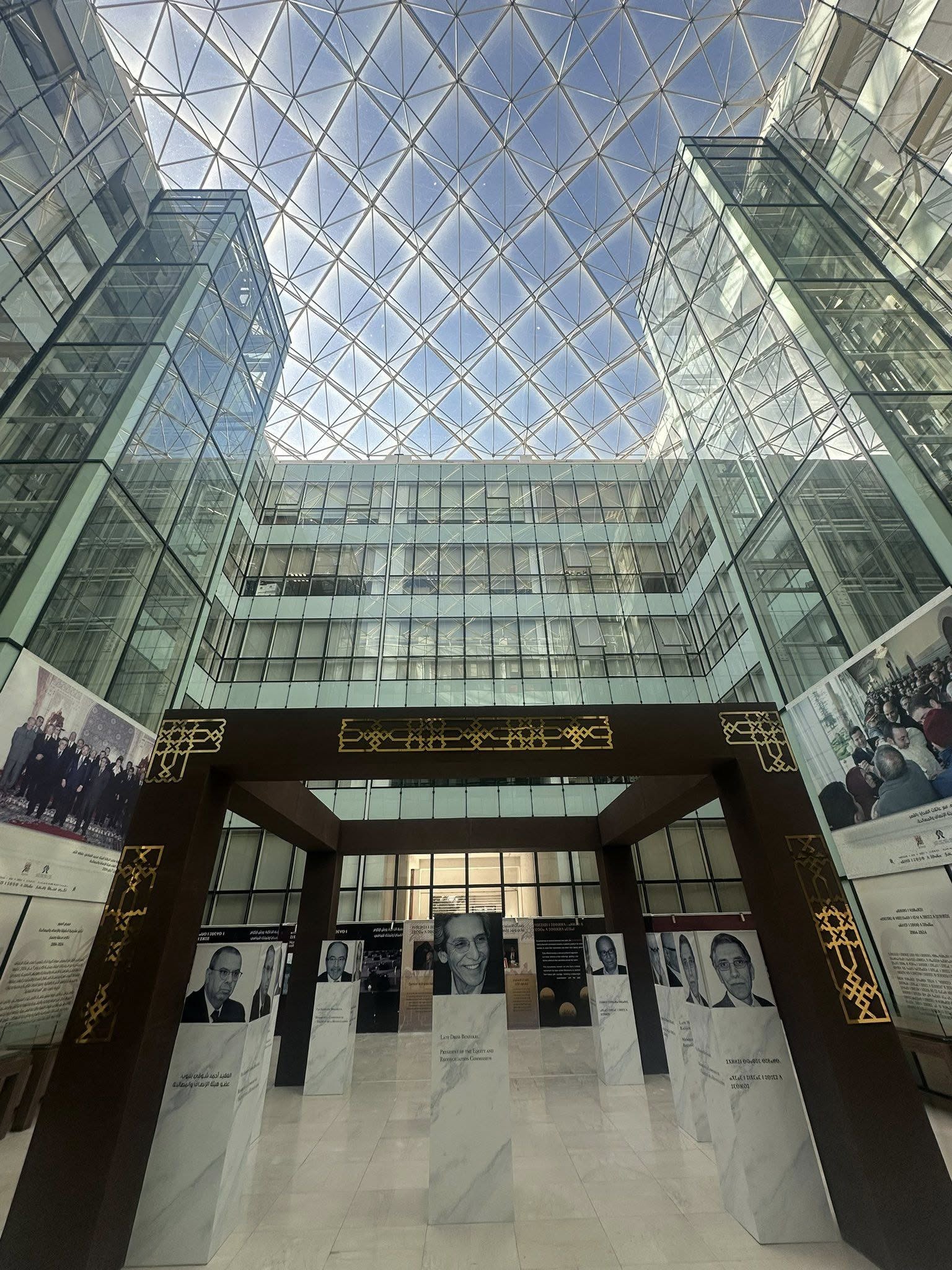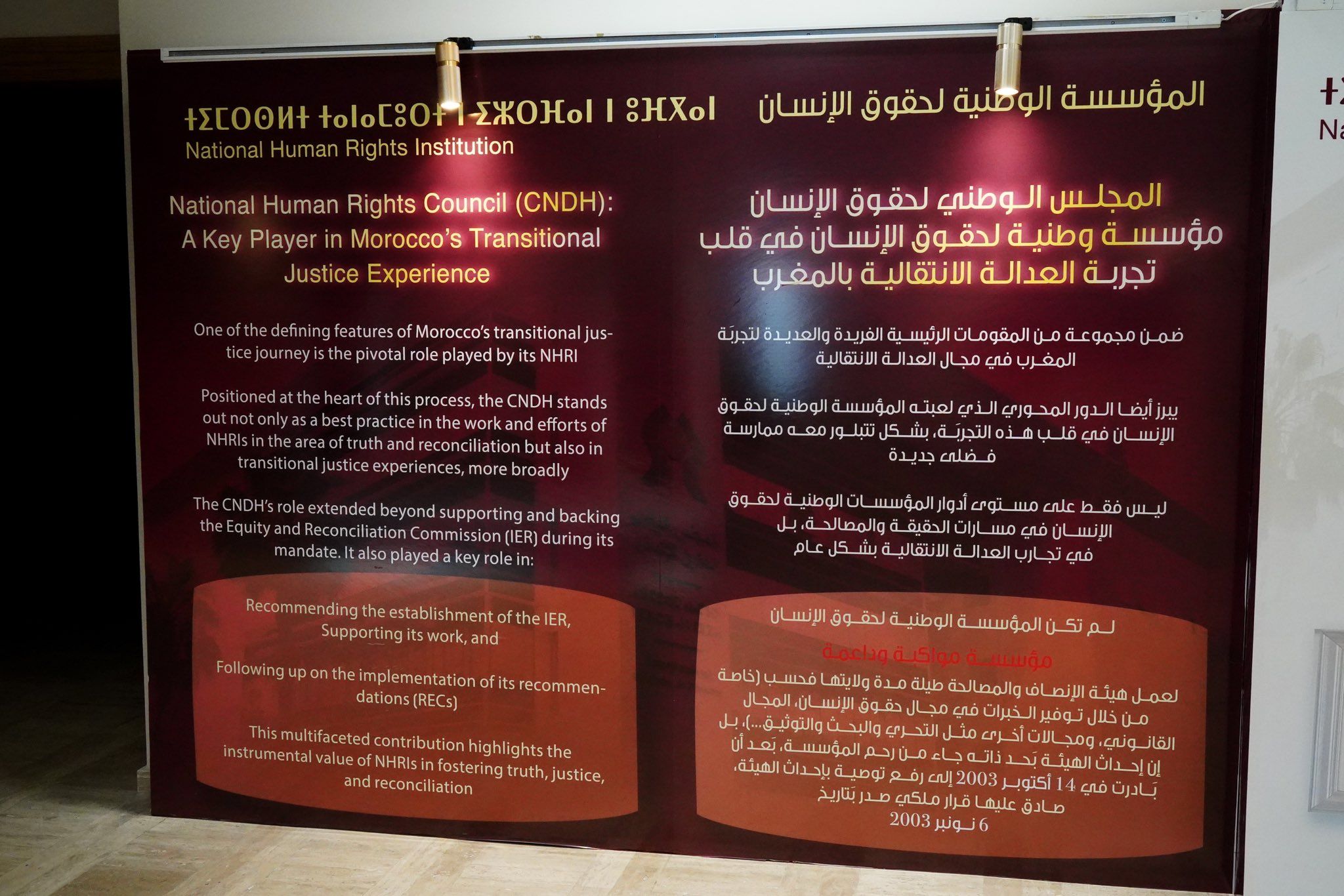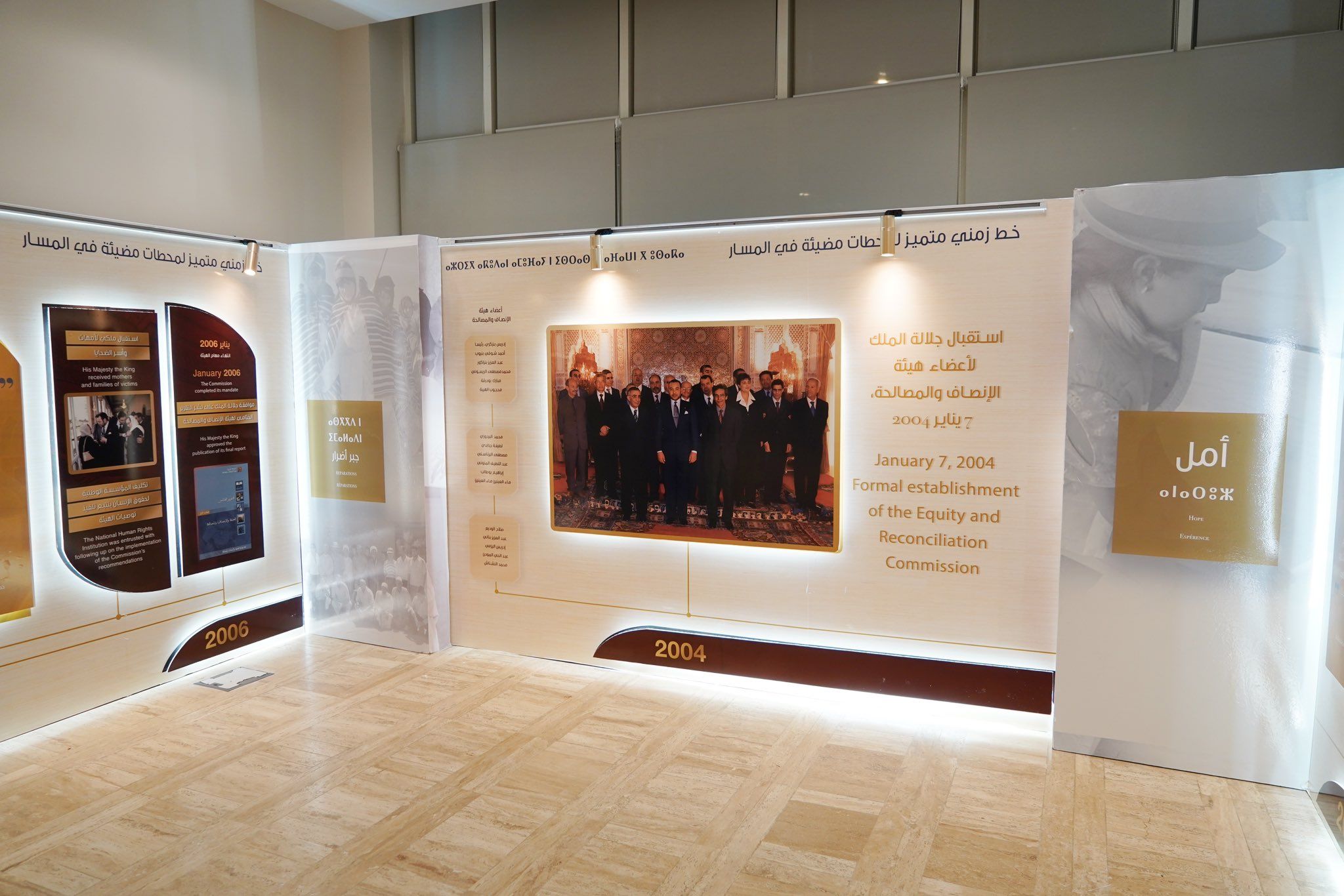- Home
- Follow-up on recommendations

About the Commission on the follow-up of the implementation of the IER recommendations
The IER issued a substantial number of recommendations and proposals to strengthen reforms and establish the necessary safeguards to prevent the recurrence of past violations. These recommendations primarily focused on strengthening constitutional guarantees of human rights, adopting and implementing an integrated national strategy to combat impunity, strengthening the rule of law, and establishing monitoring mechanisms, having considered that certain issues should be the subject of follow-up procedures and mechanisms.
On January 6, 2006, His Majesty the King received victims and their families, members of the IER, officials from political parties, and representatives of civil society organizations at the royal palace in Rabat.
During this meeting, he announced the initiation of the implementation of the recommendations. On this occasion, His Majesty addressed a message to the nation in which he assigned the CCDH with the task of implementing the recommendations of the Truth Commission.
The monitoring of the implementation of the recommendations was entrusted to the National Human Rights Institution, which had itself recommended the creation of the Independent Arbitration Commission and the IER. In this context, the CCDH, predecessor of the CNDH, established a Follow-up Committee to monitor the implementation of the IER’s recommendations. This Committee was recently restructured and strengthened in 2020.
“In 2006, His Majesty the King entrusted the Advisory Council on Human Rights, currently the CNDH, with the task of monitoring the implementation of the IER’s recommendations. We continue to carry out our monitoring mission while adapting to observed developments. For example, in 2020, we restructured the Committee on the Implementation of the IER’s recommendations, and in 2021, we established a Memory Preservation Unit, aimed at the preservation of memory and the promotion of Moroccan history and its various tributaries. Furthermore, we stay abreast of scientific advancements in the fields of forensic medicine and genetic analysis to address pending cases; the most recent actions in this regard were undertaken in 2023,“ Amina Bouayach, CNDH Chairperson.

Establishing the truth
Given the challenges that hindered its efforts to establish the truth in certain cases, the IER’s final report recommended pursuing investigations to to uncover the victims' fate. The outcome in figures: 803 disappearance cases were processed and clarified by the IER. 385 graves have been determined. 44 bone samples from the remains of victims whose fate had not been determined were collected by a team of forensic doctors between December 2005 and May 2012. These samples were sent to a foreign genetic analysis laboratory to conduct necessary genetic examinations. Out of the 44 bone samples, 35 produced positive results. DNA from 9 samples was degraded and did not yield any results. In 2022, a scientific team led by CNDH, recognizing advancements in scientific techniques for degraded DNA samples, held a meeting with the laboratory to reanalyze the 9 remaining unresolved cases. The initial results were received in July 2023.
The Follow-Up Commission continued the investigations while also ensuring the development of methodology and the modernization of tools in line with progress made in various fields. For certain complex cases, the Commission sought scientific expertise in the fields of forensic medicine and genetic analysis and collaborated with national and international laboratories.
The philosophy underlying the Moroccan experience of transitional justice has emphasized the importance of closely linking justice, reconciliation, and reparations. Various measures and initiatives, taken before the establishment of the IER, contributed to the consolidation of its foundations, including the pardon granted to political detainees, the regularization of their professional and administrative status, and the return of exiles and expatriates. Furthermore, a compensation process for victims of arbitrary detention and enforced disappearances was initiated.
It is worth noting that the Independent Arbitration Commission, which preceded the establishment of the IER, carried out significant actions in compensating victims of violations.
The approach of the IER enabled victims and their beneficiaries to receive various forms of reparations, in addition to financial compensation. These included medical and psychological rehabilitation, social reintegration, and the settlement of employment, administrative, and financial issues.
a) Financial reparation
The number of victims and right-holders who have received financial compensation provided by both mechanisms (IER and Independent Arbitration Commission) is 20,533 individuals, including 8,117 women. The total amount of compensation provided by both mechanisms is 1,334,413,327,43 Moroccan Dirhams (DHs).
b) Medical rehabilitation
Considering that reparations should not be limited to financial compensation, the IER recommended the integration of victims into national healthcare coverage systems.
Following this recommendation, an agreement was signed on July 5, 2007, between the CCDH, the Ministry of Health, the Ministry of Finance, the Ministry of Employment and Vocational Training, and the National Fund for Social Welfare Organizations (CNOPS).
As of December 31, 2022, the number of medical coverage cards distributed was 9,021, with a total amount of 216,138,771,00 Moroccan Dirhams (DHs).
In addition, the CNDH continues to provide medical assistance to complex cases. Since the establishment of the follow-up Committee, the CNDH covered 505 medical procedures, amounting to a total of 3,125,367,01 Moroccan Dirhams (DHs).
c) Social reintegration
In addition to financial compensation, 1,502 victims and their right-holders benefited from social reintegration as per the recommendations of the IER. These beneficiaries were selected based on the following criteria:
• Victims who lost their jobs in the private sector and couldn’t reintegrate socially.
• Victims who couldn’t complete their education during their detention or even
after completing it faced challenges in rejoining the workforce.
• Individuals whose physical and/or mental health conditions prevented them
from regular employment.
• Minors who were children at the time of the violations suffered by their parents.
d) Settlement of the administrative and financial Status of former victims
Before the establishment of the IER and the Independent Arbitration Commission, the government of alternate initiated the process of regularizing the administrative and financial status of 1,000 former civil servants who had been dismissed from their positions due to their political activities. Additionally, the follow-up committee resolved the status of 510 former civil servants.
As mentioned earlier, the IER recommended giving special attention to socioeconomic, cultural, and environmental rights in the reparations, particularly in regions that hosted secret detention centers and areas that experienced socio-economic marginalization.
In 2007, the CCDH established an appropriate institutional structure to oversee the implementation of the community reparation program. This structure initially entailed the creation of a Steering Committee and a Coordination body in all the relevant regions, which were subsequently organized into a unified Council of Coordinations. Additionally, the CCDH oversaw the establishment of Management Units in charge of overseeing the program and enlisted numerous partners to support its implementation.
23 agreements were signed, and 149 projects were carried out, amounting to a total of 159,799,892,00 Moroccan Dirhams (DHS). Of this amount, 75% came from a national contribution (government/CCDH/CDG Foundation/local associations), while 25% was contributed by international partners.
Legislative and Institutional Reforms proposed in the IER’s Recommendations
The Equity and Reconciliation Commission (IER) formulated several recommendations and proposals to consolidate reforms and provide the necessary guarantees of non-recurrence of past human rights violations. These recommendations were specifically geared towards constitutionally establishing human rights, adopting and implementing an integrated national strategy to combat impunity, consolidating the rule of law and instituting mechanisms and procedures to follow up on specific issues.
On January 6, 2006, His Majesty the King received victims of past violations and their families at the Royal Palace in Rabat, alongside members of the IER, political party leaders and representatives of civil society organizations to declare the initiation of the implementation of the IER’s recommendations. On this occasion, His Majesty addressed the nation and assigned the task of following up on the implementation of the recommendations outlined in the Commission’s final report to the Advisory Council on Human Rights (currently the National Human Rights Council -CNDH-).
To fulfill this mandate, the Advisory Council developed a vision and work methodology based on identifying areas for follow-up, relevant stakeholders, and effective tools for implementation. A Follow-up Committee was also established within the Advisory Council’s organs and was restructured and reinforced by CNDH in 2020.
Key recommendations of the Equity and Reconciliation Commission (IER)
Strengthen constitutional protection of human rights Continue the process of accession to international conventions related to human rights. Strengthen legal and judicial mechanisms for protecting human rights. Establish a strategy to combat impunity. Undertake a comprehensive overhaul of criminal policy and legislation. Upgrade the justice system and reinforce its independence. Rationalize security governance. Promote human rights through education and awareness-raising. Encourage scientific research in the field of past and contemporary Moroccan history. Create a commission within the Advisory Council on Human Rights to monitor the implementation of the IER’s recommendations Preserve and organize IER archives at the Advisory Council on Human Rights Establish medical coverage for victims of past human rights violations Consolidate respect for the rights of Moroccan nationals living abroad. Complete the process of promoting and protecting women's rights through a comprehensive national strategy. Take necessary measures to repair the damage suffered by detainees held by the Polisario and those in Tagounit. Take necessary measures to repair individual and collective damage suffered by regions affected by the events of 1960, 1967 and 1973. Preserve archives through a royal order, and continue investigations, particularly in cases of enforced disappearance and deaths during social events. Open a hotline at the Advisory Council on Human Rights for families affected by social events.
The preservation of memory has been a pivotal aspect of Morocco’s transitional justice experience, encompassing the initiatives of the IER, along with the actions of the CCDH and subsequently the CNDH in implementing the IER’s recommendations.
Within this framework, sixteen projects were realized by different associations, with a combined budget of 8,611,812,56 Moroccan Dirhams.
The CNDH continues its efforts to preserve memory in collaboration with the government. This includes the restoration and enhancement of burial sites and the construction of commemorative stone memorials at various locations, including:
Stone Memorial for the victims of Skhirat at Laalou Cemetery in Rabat.
Stone Memorial and burial of the victims of the former prison of Agdez in a cemetery dedicated to them.
Stone Memorial and the renovation of the cemetery of the former Kelaat M’Gouna prison, burial of the victims in a cemetery dedicated to them
Stone Memorial and the renovation of graves for the victims of the January 1984 events in Nador.
Development of a cemetery and a Stone Memorial for the victims of the June 20, 1981 events in Casablanca and a dedicated cemetery, the restoration project of which is underway. The public transport station in front of the cemetery is called Station Chouhada (martyrs’ stations).
Development of the former Tazmammart prison, including a cemetery and a socio-cultural center for the village, to transform it, in consultation with NGOs, into a space for developing economic, social and environmental initiatives and activities.
Establishment of a memory preservation museum in Al Hoceima.
The IER also introduced an innovative approach to memory preservation, seeking to repurpose former irregular detention centers into sociocultural and productive projects. This innovative approach aimed to both preserve memory and contribute to the economic revitalization of the affected regions. In this context, meetings and consultations were organized with victims, local stakeholders including elected officials, associations, political parties, and local authorities in regions where these centers were located, as well as individuals and groups residing in these regions.
It should be noted in this context that the CNDH established a Memory Preservation Unit, aimed at the preservation of memory and the promotion of Moroccan history and its various tributaries. The establishment of this Unit is part of the ongoing efforts to address political and historical issues related to human rights. It aligns with the implementation of recommendations advocating a re-examination of past events to draw lessons from them. The Unit also seeks to launch initiatives to engage with various personal narratives surrounding historical events related to past violations, conduct research and debates on these events, rehabilitate memory centers, establish museums,
and preserve archives.
In summary, the impact of the IER extended beyond the report itself. Its recommendations laid the groundwork for institutional and legal reforms designed to prevent future violations. In this context, the year 2011 is engraved in Morocco’s history as a period of profound transformation and progress. The adoption of a new Constitution, which embedded guarantees for fundamental rights in its preamble and throughout its articles (60 out of 180), marked a turning point by prioritizing human
rights in Moroccan public policies and the political system.
In conformity with the IER’s recommendations, this Constitution underscores Morocco’s commitment to human rights as universally recognized, and its determination to continue working towards preserving peace and security worldwide. Furthermore, it emphasizes the primacy of duly ratified international conventions. The constitutional provisions have been implemented in line with the recommendations of the IER, which specifically aimed at continuing the process of acceding to international conventions related to human rights8. This Constitution introduced significant measures that, among others, strengthened the separation of powers and the protection of human rights.
The establishment of the National Human Rights Council (CNDH) as an independent constitutional institution with a mandate to protect and promote human rights, further contributes to consolidating these advancements and ensuring their sustainability.
In summary, the 2011 Constitution reshaped the balance of power within the state by strengthening accountability and consolidating the role of political parties and civil society in the democratic process. The adoption of this Constitution and the institutional strengthening of human rights, especially with the promotion of the new concept of authority and the inclusion of a participatory approach to human rights and democracy in national public policies, have further reinforced the foundations of the rule of law and democracy in Morocco.
Other initiatives and developments should be noted in this regard, such as the adoption of the National Action Plan on Democracy and Human Rights in Morocco (PANDDH) and the establishment of an NGO platform to strengthen citizen participation, to cite just these two examples. The PANDDH, which was the first experience of its kind in the region of North Africa and the Middle East, integrated both the democracy and human rights dimension and responded to the need for a coherent framework allowing the inclusion and coordination of all actions aimed at the dissemination, promotion, protection and strengthening of respect for human rights in Morocco.
Follow-up Committee’s achievements
The IER made several recommendations, encompassing aspects related to memory and history. Among these recommendations were the rehabilitation of centers related to enforced disappearance and arbitrary detention, as well as cemeteries where past victims are buried. The IER also recommended the implementation of a contemporary law on archives, the establishment of a museum chronicling the history of Moroccan emigration and the creation of an independent research institute dedicated to the history of Morocco.
The following materials showcase several achievements of the Committee’s:








